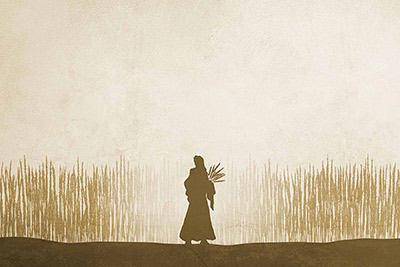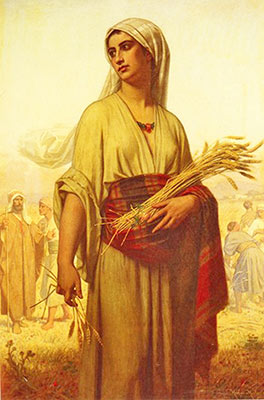THERE'S ROMANCE IN THE BIBLE
Hay Historia de Amor en la Biblia
by
Mary Hunt Webb
Posted Monday, January 31, 2022

There's romance within the pages of the Bible. [Photographer: Ylanite Koppens. Photo courtesy of Pixabay.com.]
When I read through the Bible each year, I look forward to reading the book of Ruth that tells about the young Moabite widow who left her homeland to follow her former mother-in-law to Bethlehem in Israel. Buried in that account is a love story, and who doesn't enjoy a love story with a happy ending?
All the current advice on how to meet the love of your life says, "Don't fall in love with someone at work. If it doesn't work out, you still have to face that person on the job every day. Stay away from workplace romances." But Ruth met Boaz at work. (See Ruth 2:1-8 in the Bible for the details of how they met.)

The story of Ruth and Boaz violates all contemporary wisdom about workplace romance. [Illustrator: Jeff Jacobs 1990. Illustration courtesy of Pixabay.com.]
Moreover, conventional wisdom says don't fall in love with the boss! But Ruth 2:3-4 tells us that as Ruth was gathering grain in a barley field, the wealthy owner of that field arrived. His name was Boaz, and he was a relative of Ruth's deceased father-in-law, Elimelek: "3) So she (Ruth) went out, entered a field and began to glean behind the harvesters. As it turned out, she was working in a field belonging to Boaz, who was from the clan of Elimelek. 4) Just then Boaz arrived from Bethlehem and greeted the harvesters, 'The Lord be with you!' 'The Lord bless you,' they answered." (NIV)
Boaz noticed that there was an extra worker in the field so, in Ruth 2:5, he asked his foreman whom she belonged to. It was a discreet way of asking, "Is she married? Is she single? Is she someone's wife or daughter?"
Once Boaz found out that Ruth was a widow, it was then acceptable for him to speak to her. The first thing he did was to address her need to work. He did that in Ruth 2:8 when he told Ruth to remain and work for him. That was the first sign that he was interested in her.
Boaz then saw to Ruth's needs by seeing to it that she had enough to eat and drink during the midday meal. Ruth 2:14 tells us that, "At mealtime Boaz said to her (Ruth), 'Come over here. Have some bread, and dip it in the wine vinegar.' When she sat down with the harvesters, he offered her some roasted grain. She ate all she wanted and had some left over." (NIV) That was his first step in his courtship of Ruth because the gift of food is an indication of caring and of nurturing.
Next, Boaz saw to Ruth's needs by telling his foreman in Ruth 2:15-16, to see to it that extra grain remained where Ruth could get it.

In 1876, the French realist, Merle Hugues, painted this portrayal of the young widow, Ruth, gathering barley. Since the man in the lower left of the painting appears to be looking at Ruth, the artist has created the impression that the man is Boaz and that he is talking to his foreman. In the background on the lower right, it appears there are other workers that are involved in the harvest. [Artist: Merle Hugues. Illustration courtesy of artrenewal.org]
When a man is courting a woman, he often gives her a gift or two. The gift that Boaz gave Ruth was barley, as we see in Ruth 3:15. We might not see that as high romance. It certainly wasn't as romantic as a gift of flowers, but Ruth didn't need flowers. She needed food, and Boaz recognized her need.
The scripture does not tell us anything about the physical appearance of either Ruth or Boaz. The Bible does not say that Ruth was a stunning beauty, but the fact that Ruth was a penniless, foreign widow did not deter Boaz. He recognized in her an inner beauty and dedication that caused her to leave her homeland to care for her mother-in-law.
Those qualities ignited love that resulted in Ruth being catapulted from poverty to wealth when she became Boaz's wife. Beyond that, she became part of the royal bloodline when she gave birth to Obed, the grandfather of David, the shepherd-king. Through them, she was in the lineage of Jesus. As a result, Ruth is one of two women for whom a book in the Bible is named, along with Esther.
How's that for a love story with a happily-ever-after ending?
BIBLE VERSES USED IN THIS POSTING
Ruth 2:3-4 — 3) So she (Ruth) went out, entered a field and began to glean behind the harvesters. As it turned out, she was working in a field belonging to Boaz, who was from the clan of Elimelek. 4) Just then Boaz arrived from Bethlehem and greeted the harvesters, 'The Lord be with you!' 'The Lord bless you,' they answered. (NIV)
Rut 2:3-4 — Fue (Rut), pues, y llegando, espigó en el campo en pos de los segadores; y aconteció que aquella parte del campo era de Booz, el cual era de la familia de Elimelec. 4) Y he aquí que Booz vino de Belén, y dijo a los segadores: Jehová sea con vosotros. Y ellos respondieron: Jehová te bendiga. (Reina-Valera 1960)
Ruth 2:14 — At mealtime Boaz said to her (Ruth), 'Come over here. Have some bread, and dip it in the wine vinegar.' When she sat down with the harvesters, he offered her some roasted grain. She ate all she wanted and had some left over. (NIV)
Rut 2:14 — Y Booz le dijo a la hora de comer: Ven aquí, y come del pan, y moja tu bocado en el vinagre. Y ella se sentó junto a los segadores, y él le dio del potaje, y comió hasta que se sació, y le sobró. (Reina-Valera 1960)

"And they lived happily ever after.". [Photographer: Sam Williams. Photo courtesy of {Pixabay.com]
